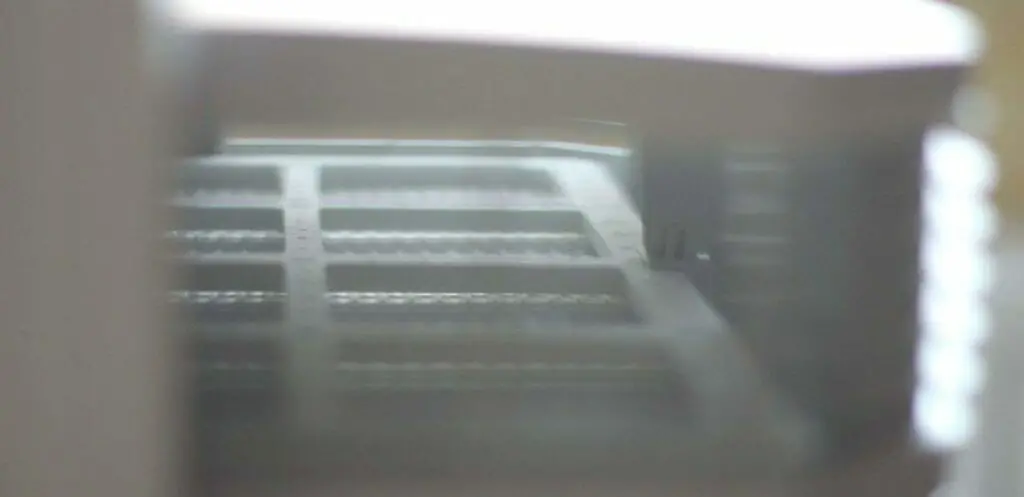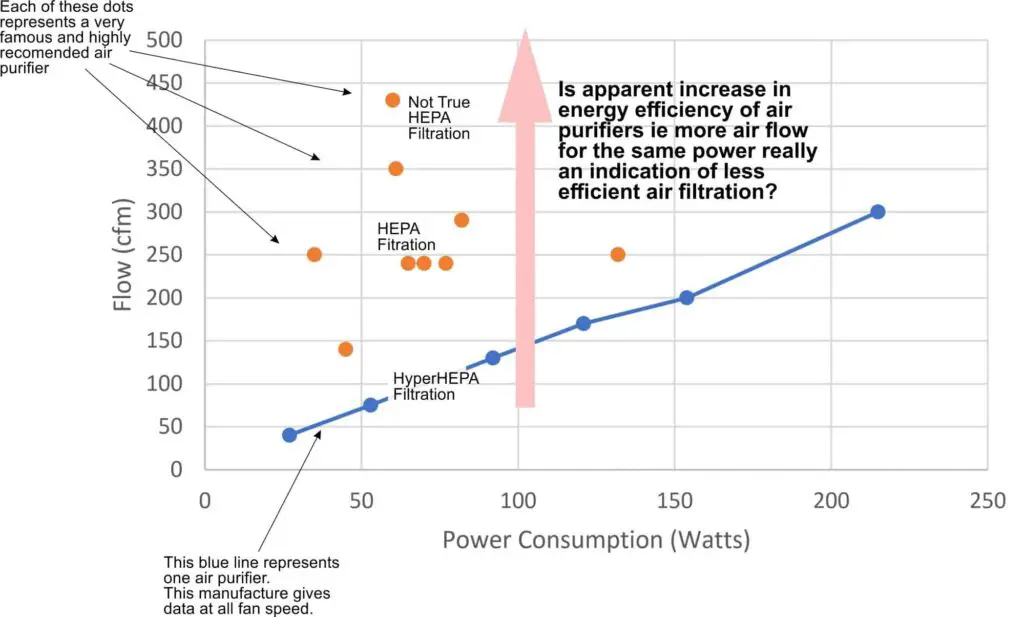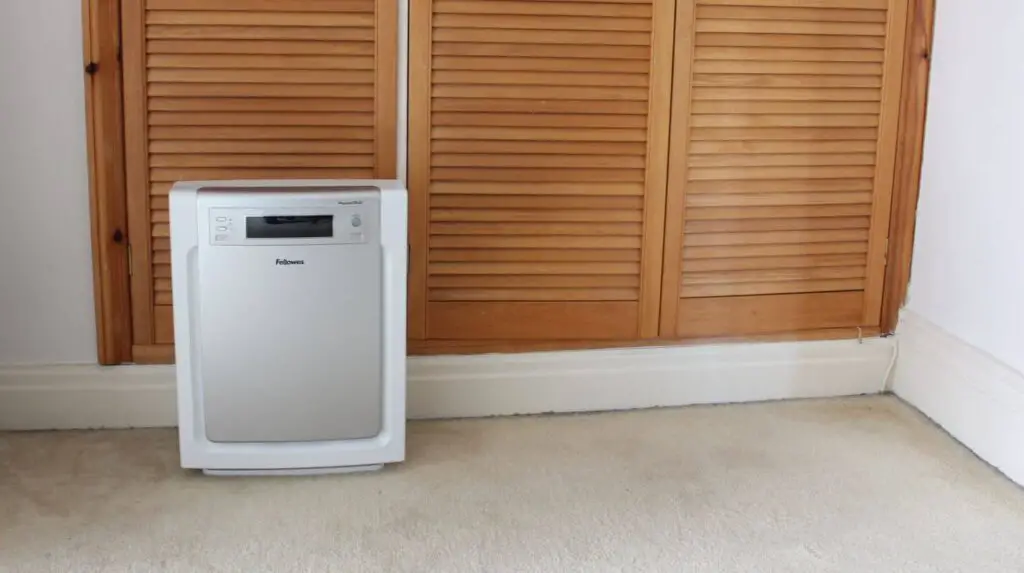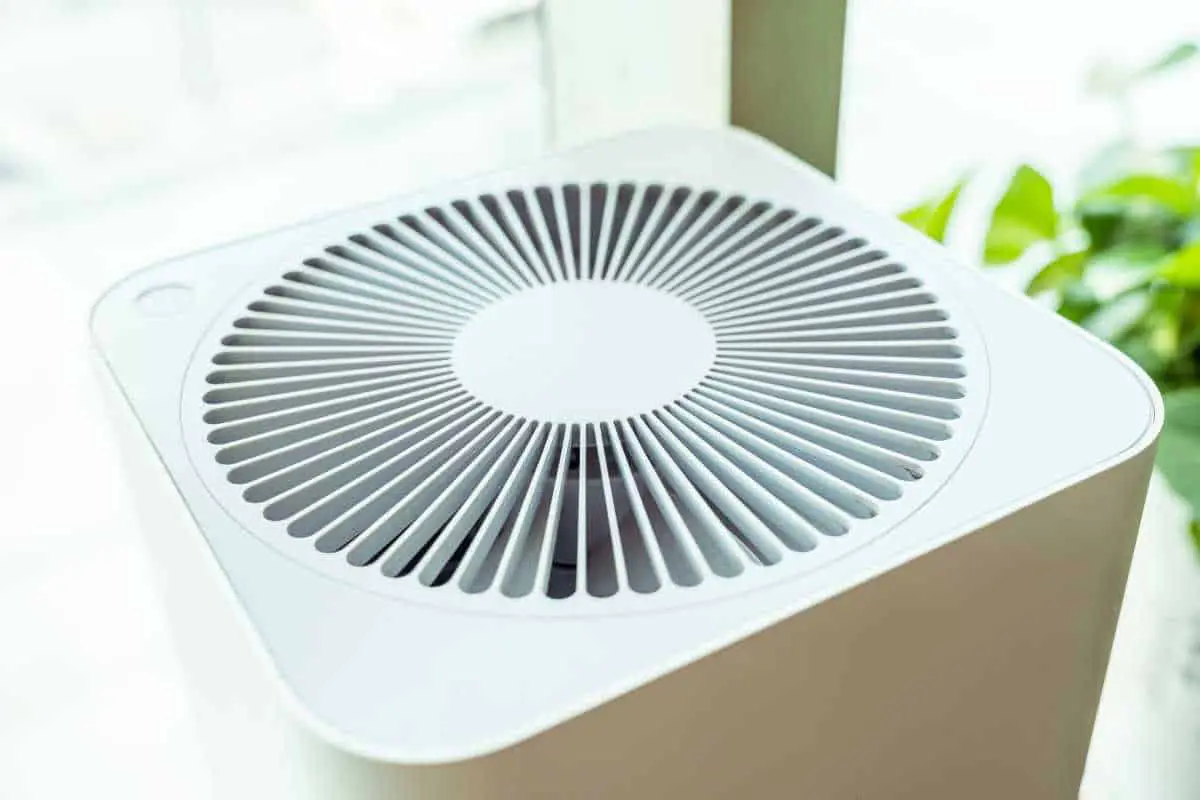I use an air purifier 24/7. I have one in my office, one in the kitchen and one in our bedroom. They probably get through approximately 3 kW per day. So energy consumption is an issue. On the other hand, towards the end of this article I give you a reason to be very wary of air purifiers that promise very high energy efficiency.
As a general rule air purifiers use between 70-200 watts. The energy consumption depends on the motor, the fan speed, fan architecture and the efficiency of the filter for removing particles. You should be careful buying an energy efficient air purifier as it may not be as effective for your health.
Do air purifiers use a lot of electricity and should I just buy the most energy efficient model? It seems an easy question, but you should be wary of doing this. Let’s consider why.
There are many features that affect the energy efficiency of a fan/filter air purifier. This is the most effective and most common type of air purifier for removing particles from the air. I have a section towards the end about other types.
The Power of the Fan Motor Will Influence The Energy Consumption
The efficiency of the motor is obviously important in the electricity consumption. An electric motor can have an efficiency of 50-96%. The wasted energy is turned into heat and dissipated into the room. The efficiency of an electric motor is best at 75% of the maximal load. So if an air purifier has a motor that is too large it will be running well below its maximal efficiency and so consuming more electricity than one that is smaller and runs at 75% of maximum load. The technology of electric motors a very well established with the first brushless electric motor being developed in 1962. So all manufacturer’s use the most efficient size of motor for their air purifiers.
Power Consumption Depends on Fan Speed/Air Speed
The faster the fan needs to spin, the greater will be its electricity consumption. This is clearly seen in the graph below, the straight line represents the same air purifier at different airflows. Clearly the fan needs to spin faster for a higher airflow. To achieve this, a higher power consumption by the fan motor is needed. In fact, the airflow goes up linearly with power consumption.

Fan Architecture Also Affects Energy Efficiency
We all know what a normal fan looks like. In the image below there is an air purifier fan that has been specially designed. It increases the efficiency of converting power into airflow whilst reducing noise.
So manufacturers have put a lot of effort into designing efficient and quiet fans over the years. They have all had plenty of time to see each other’s designs and settle on similarly efficient fans. So this is not a major source of difference in energy efficiency between manufacturers.

The Air Purifier Needs to be on All the Time Which is a Major Factor in the Amount of Energy Used
One factor that we all need to be aware of is that if there is a concern regarding air pollution, the air purifier needs to be on all the time. Once you switch it off the particle count in the air will rise quickly After 15 minutes after switching the air purifier off, the particle count will be back to polluted levels. Actually, an air purifier takes some time to lower the particle count in a room. So it needs to be on in the room for 45 minutes before you step into the room. So at some times of the day you will have an air purifier on in the room that you are going to be in as well as the room that you are in. So you are going to need one for your bedroom and one for wherever you spend most of the daytime. Both of these will need to be run at a speed that changes the air in the rooms 5 times per hour.
Some Air Purifiers Use Very Much Less Electricity Than Others Are They Better?
Strangely, air purifiers that use or less electricity are may be worse at removing particles from the air. The reason is that if with a small amount of power they can get a large enough air flow through the purifier, it implies the filter is letting a lot of air through quite easily. This means that the sort of nanoparticles that can enter your bloodstream may be getting through the filter quite easily. The whole purpose of buying the air purifier is to protect your health, Unfortunately by buying an air purifier for its energy efficient you may be defeating the reason for which you bought the air purifier in the first place.
Of course to reduce indoor air pollution effectively the air purifier has to filter enough air. The EPA recommends a portable air purifier should be able to filter the air in the room about 5 times per hour. This will reduce air pollutants in the air by 80%.
This diagram shows the air flow through some of the most recommended air purifiers at different power consumptions. Each orange dot is from one purifier selected because they are some of the most highly recommended air purifiers on the market. There is only one manufacturer that gives consumers the data for all power settings for their air purifier. Other manufacturer’s give flow rates or data from which flow rate can be calculated at the maximum flow rate. At the most popular power consumption at about 60 watts we can see that there are flow rates varying between the air purifier represented by the blue line-100 cfm and the air purifier with a filter that is not a true HEPA filter of 350 cfm. The more than 3 fold variation seems to change with the filtration efficiency as the flow rate increases from a “Hyper-HEPA” filter through HEPA filter to a filter that is known not to be a true HEPA filter (although close).

So the efficiency of the filter is likely the dominant determinant of power consumption. This implies that you could be better off buying the air purifier with the highest power consumption, as the filter is likely to be more effective!
If a manufacturer has installed a revolutionary motor for the fan which is much more energy efficient this could explain the higher flow rate at lower power consumption eg the Oransi EJ120.
You may ask well how can this happen if I buy an air purifier with a HEPA specification filter surely all filters must filter to the same extent? Unfortunately, the only specification of the HEPA filtration standard is that the filter removes 99.97% of particles 0.3um in diameter. However, airflow through the filter when achieving this is not specified, and in general filters work best at low flow rates. So a filter could truly be categorised by a manufacturer as a HEPA air filter at the lowest airflow setting, but the same filter would not perform to HEPA standards at the higher flow rates that usually sell the air purifier.
Now of course there are some exceptions to this general rule. One example is a manufacturer use the addition of electrostatic attraction of particles to the filter to compensate for a looser filter. These can lose their electrostatic charge with time and need changing more often. For one manufacturer, this is every 6 months as opposed to every 24 months with a very efficient “tight” filter and pre-filter. So also what you save in electricity you can lose in filter changes.
I find it disappointing that I could only find one manufacturer who gave energy usage and flow rates at every setting of their air purifier. This manufacturer also gave noise levels at each setting. This helps consumers buy an air purifier that is not too loud but still effective on a midrange setting. There could be others, but I did not see any.
Paradoxically, this is one appliance where you probably do not want the most energy efficient model! What you need is efficiency at particle remove, which we know is linked to health outcomes.
The energy star rating should I feel not be a reason for buying an air purifier rather it may be an indication of a poor filter.

Is an Ultraviolet Light or Ionic Air Purifier More Energy Efficient?
A UV light for an air purifier consumes about 20 watts and ionic air purifiers 50 watts. An ozone generator consumes 130 watts but should not be used as an air purifier if people will be in the room. This is because as ozone is damaging to lungs, may cause irritation of the eyes and has been associated with an increased incidence of cancer. A Molekule device consumes up to 80 watts depending on its setting. Also, none of the above are as effective at removing particles from the air as a HEPA air purifier.
Carbon filters to remove chemicals need air flow and so are really part of the fan/filter design of a room air purifier.
Context-How Much Electricity do Other Household Items Use?
An air purifier will use 75-150 watts when purifying the air. Here is a table to show how this compares to other devices-
| Device | Power Consumption (Watts) |
|---|---|
| Central Air Conditioning Unit | 3500 |
| Fan Heater | 3000 |
| Dehumidifier | 500 |
| Fridge | 150 |
| Air Purifier | 75-150 |
| Ceiling Fan | 75 |
| Freezer | 70 |
| TV | 60-200 |
| Portable Computer | 75 |
| Humidifier | 60 |
| Phone charger | 4 |
So the electricity use of an air purifier is fairly average for a household electrical device that does not heat the house. An HVAC system which can also work as a slightly lower grade air purification system uses much more electricity if warming the air or acting as an air conditioner.
Can I Turn My Air Purifier Down to Save Electricity?
It has probably occurred to most people with an air purifier to turn it down but usually to reduce noise. I have done this and then found that the lower setting did not adequately clean the air when I used a meter. So you can save electricity by turning the air purifier down, but your indoor air quality will deteriorate to the point where it puts your health at risk. If you do, it would be best to test the air with an air quality meter so that you do not put your health at risk.
Conclusion-do air purifiers use a lot of electricity
So do air purifiers use a lot of electricity? You would probably need about 2-3 kW hours per day to give you CDC approved 24 hour air purification for 2 people using 3 air purifiers. It depends on room size but this would be a reasonable ballpark estimate.
As explained above, you may be better buying an air purifier that uses more rather than less electricity!
The first rule of buying an air purifier is never buy an air purifier without a HEPA filter. “HEPA like” “HEPA type” are not good enough. The second is to buy one with a fan that will push enough air through the filter for your room size. So you need a fairly powerful fan. The difficult part is finding an air purifier that will do this at a setting on which you can live with the noise.

